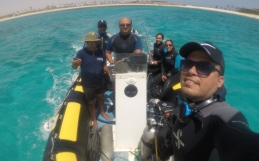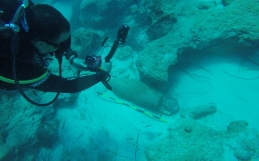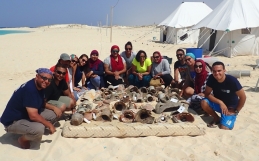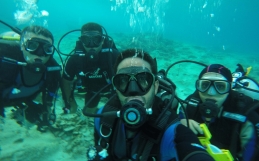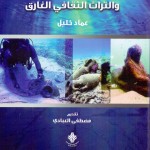The 2016 season extended from the 12th to the 27th of August during which 124 dives were carried out by a team of graduate students from the Alexandria Centre for Maritime Archaeology & Underwater Cultural Heritage.
The objective of the 2016 season was to develop 3D models of the main areas that contain concentrations of ceramics within the bay of Marsa Bagoush. Also during this season, several areas outside the bay were explored which resulted in the discovery of a new site. Accordingly, at present, we have recorded the remains of cargo items from four shipwrecks which date to the Hellenistic, Roman and Islamic periods, as well as the 19thcentury.
The remains of at least 150 amphorae were recorded inside the bay the majority of which are Egyptian amphorae from the early Roman period, probably produced in the Mareotic region west of Alexandria. This indicates the existence of at least one shipwreck of that date. The rest of the remains date back to the Late Roman/Islamic period. That is in addition of two grapnel anchors and one admiralty 19thcentury anchor. Outside the bay, in 13m deep water, several clusters of Egyptian Hellenistic amphora sherds were recorded, indicating the existence of a different shipwreck.
Among the interesting items that were found during this season is a wooden mast that measures 7m. The mast was trapped under rocks at c. 13m deep of water. The mast was located c. 120m to the east of the Hellenistic amphora sherds outside the bay. Another unique item was a grinding stone that was found c. 50m north of the same site.
The seabed and archaeological remains were modeled using photogrammetry techniques with the aid of trilateration methods. The 3D models will be used for the study of site formation and the distribution of artifacts. It will also be used for presenting the site to the non-diving community.
On the other hand, a preliminary survey was carried out on-land to the south of the shoreline. The survey resulted in discovering a series of interconnected rock-cut cisterns which probably date to the Roman Period. The cisterns are solid evidence that the site was occupied in antiquity. During the coming season, excavation of some silted spots inside the bay will be conducted using water dredges in order to expose and record the buried remains. Moreover, fabric analyses of ceramic samples will be carried out to determine its clay type and hence its exact origin. Also, a sample of the wooden mask will be collected for dendro dating. More exploration of the deeper water outside the bay will be also carried out.
Finally, a management plan of the site will be developed with the objective of preserving its remains in situ and utilizing the site as a training facility for underwater archaeology.

